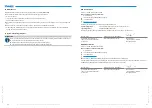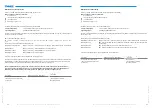
INSTALLATION AND OPERATING INSTRUCTIONS:
GEH6000IL/GED6000IL
INSTALLATION AND OPERATING INSTRUCTIONS:
GEH6000IL/GED6000IL
38
39
EN / 2021-07-28
DDOC00212 / 0
EN / 2021-07-22
DDOC00212 / 0
Zimmer GmbH
•
Am Glockenloch 2
•
77866 Rheinau, Germany
•
+49 7844 9138 0
•
www.zimmer-group.com
Zimmer GmbH
•
Am Glockenloch 2
•
77866 Rheinau, Germany
•
+49 7844 9138 0
•
www.zimmer-group.com
71 – Force profile – high clock rate for energy-saving gripping
Behaves like mode 70, but when the gripping movement starts, the unlocking operation is omitted. This starts the
movement immediately and enables a shorter response time in the gripping direction towards the BasePosition. It must be
ensured that in the WorkPosition, no external forces act on the gripper jaws.
73 – Force profile – with holding pressure for detecting part loss - standard
Behaves like mode 70, but in addition, in this mode, the motor is energized continuously after gripping the workpiece, which
results in further movement to the BasePosition when parts are lost. This enables the part loss to be detected by sensing
the BasePosition, otherwise the TeachPosition bit is TRUE.
Ö
This mode is the
recommended standard operating mode
!
75 – Force profile – without holding pressure for flexible/elastic components
Behaves like mode 70, but the product has a lower movement speed because the majority of the gripping force is created
directly by the motor current. However, it will no longer be possible to generate the full nominal force because of the lower
kinetic energy. Therefore, this movement profile is better suited for flexible workpieces. The gripping force generated in
these movement profiles depends on the elasticity of the workpiece.
Group 70 – Inside gripping
DeviceMode
Action
ControlWord
7x
Move toward the WorkPosition for opening the product.
0x0200
70
Move toward the BasePosition until this position or the workpiece is reached and
switch off the motor.
0x0100
71
Move toward the BasePosition without an unlocking process until this position or
the workpiece is reached and switch off the motor.
0x0100
ho
Move toward the BasePosition until this position or the workpiece is reached and
detect part loss.
0x0100
75
Move toward the BasePosition until this position or the workpiece is reached.
Mode for elastic components.
0x0100
11.13.4
Pre-positioning – Force profiles
The following modes can be used for force-fit
gripping of workpieces.
The gripping force is built up by the movement
speed of the gripper jaws and the motor
current. To do this, the product calculates
the required movement speed (GripVelocity)
automatically from the GripForce parameter.
When gripping a workpiece, independent
mechanical locking is achieved in the
mechanical system, making it possible to
hold the workpiece while de-energized. To
disengage from this reliably, this requires a
special unlocking procedure. For opening, a
movement automatically takes place toward the
standby position at DriveVelocity. To do this,
the product switches into positioning mode
automatically.
The difference to DeviceModes 60/70 is in the
use of pre-positioning. Therefore, this mode
is particularly well suited to time-optimized
gripping with long strokes followed by force-fit
gripping.
The graphic applies to Mode Group 80 and
thus shows outside gripping.
For Mode Group 90, exchange the BasePo-
sition and the WorkPosition.
Gripping (in the direction of WorkPosition):
WorkPosition
Speed in %
DriveVelocity
BasePosition
Position in mm
PositionTolerance (PT) PT
PT
PT
PT
PT
ShiftPosition
TeachPosition
GripVelocity
(calculated)
Open:
WorkPosition
Speed in %
DriveVelocity
BasePosition
Position in mm
PositionTolerance (PT) PT
PT
PT
Parameter
Description
BasePosition
Open position
WorkPosition
Closed position – behind the workpiece
GripForce
Desired gripping force
TeachPosition
Expected position of the workpiece
PositionTolerance
Permitted tolerance for the position window
Since gripping should occur in one direction only, the positioning mode is used automatically in the opposite direction.
To do this, the product switches into positioning mode automatically when moving in the opening direction.
The movement profile determines the direction in which the workpiece is gripped:
•
For outside gripping, the movement profile group 80 is used.
•
For inside gripping, the movement profile group 90 is used.














































